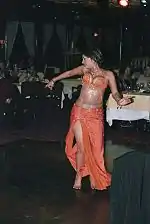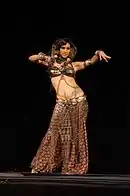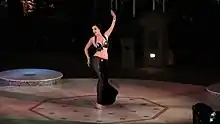Belly dance
Belly dance (Egyptian Arabic: رقص بلدي, translated: Dance of the Country/Folk Dance, romanized: Raks/Raas Baladi) is a dance that has its origins in Egypt.[1][2] It features movements of the hips and torso.[3] It has evolved to take many different forms depending on the country and region, both in costume and dance style; with the Egyptian styles and costumes being the most recognized worldwide due to Egyptian cinema. The Egyptian style with its traditional Egyptian rhymes is popular worldwide with many schools around the globe now practicing it.
.jpg.webp)
| This article is part of a series on |
| Life in Egypt |
|---|
 |
| Culture |
|
| Society |
|
| Politics |
|
| Economy |
|
|
Egypt portal |
| Part of a series on |
| Arabic culture |
|---|
 |
Names and terminology
"Belly dance" is a translation of the French term danse du ventre. The name first appeared in 1864 in a review of the Orientalist painting The Dance of the Almeh by Jean-Léon Gérôme.[4][5]

The first known use of the term "belly dance" in English is in reference to the Middle Eastern dancers who performed at the Exposition Universelle in Paris in 1893.
The informal, social form of the dance is known as Raqs Baladi ('Dance of the Country' or 'Folk Dance') in Egyptian Arabic and is considered an indigenous dance. Raqs sharqi ('Eastern Dance') is a broad category of professional forms of the dance, including forms of belly dance popularly known today, such as Raqs Baladi, Sa'idi, Ghawazee, and Awalim.

Belly dance is primarily a torso-driven dance, with an emphasis on articulations of the hips.[6] Unlike many Western dance forms, the focus of the dance is on isolations of the torso muscles, rather than on movements of the limbs through space. Although some of these isolations appear similar to the isolations used in jazz ballet, they are sometimes driven differently and have a different feeling or emphasis.
Movements found in belly dance
In common with most folk dances, there is no universal naming scheme for belly dance movements. Many dancers and dance schools have developed their own naming schemes, but none of these is universally recognized. The following attempt at categorization reflects the most common naming conventions:[7]
- Percussive: Staccato movements, most commonly of the hips, used to punctuate the music or accent a beat. Lifts or drops of the hips, chest or rib cage, shoulder accents, hip rocks, hits, and twists.
- Fluid: Flowing, sinuous movements in which the body is in continuous motion, used to interpret melodic lines and lyrical sections in the music, or modulated to express complex instrumental improvisations. These movements require a great deal of abdominal muscle control. Typical movements include horizontal and vertical figures of 8 or infinity loops with the hips, horizontal or tilting hip circles, and undulations of the hips and abdomen. These basic shapes may be varied, combined, and embellished to create an infinite variety of complex, textured movements.
- Shimmies, shivers and vibrations: Small, fast, continuous movements of the hips or ribcage, which create an impression of texture and depth of movement. Shimmies are commonly layered over other movements, and are often used to interpret rolls on the tablah or riq or fast strumming of the oud or qanun (instrument). There are many types of shimmy, varying in size and method of generation. Some common shimmies include relaxed, up and down hip shimmies, straight-legged knee-driven shimmies, fast, tiny hip vibrations, twisting hip shimmies, bouncing 'earthquake' shimmies, and relaxed shoulder or rib cage shimmies.
In addition to these torso movements, dancers in many styles will use level changes, traveling steps, turns, and spins. The arms are used to frame and accentuate movements of the hips, for dramatic gestures, and to create beautiful lines and shapes with the body. Other movements may be used as occasional accents, such as low kicks and arabesques, backbends, and head tosses.
In the Middle East
Origins and history

Belly dancing is believed to have had a long history in the Middle East.[3] Several Greek and Roman sources including Juvenal and Martial describe dancers from Asia Minor and Spain using undulating movements, playing castanets, and sinking to the floor with "quivering thighs", descriptions that are certainly suggestive of the movements that are today associated with belly dance.[8] Later, particularly in the 18th and 19th centuries, European travellers in the Middle East such as Edward Lane and Flaubert wrote extensively of the dancers they saw there, including the Awalim and Ghawazee of Egypt.
In his book, Andrew Hammond notes that practitioners of the art form agree that belly dance is lodged especially in Egyptian culture, he states: "the Greek historian Herodotus related the remarkable ability of Egyptians to create for themselves spontaneous fun, singing, clapping, and dancing in boats on the Nile during numerous religious festivals. It's from somewhere in this great, ancient tradition of gaiety that the belly dance emerged."[2]
In the Ottoman Empire, belly dance was performed by women and later, by boys, in the Sultan's palace.[9]
Social context
Belly dance in Egypt has two distinct social contexts: as a folk or social dance.
As a social dance, belly dance (also called Raqs Baladi or Raqs Shaabi in this context) is performed at celebrations and social gatherings by ordinary people (male and female, young and old), in their ordinary clothes.[10] In more conservative or traditional societies, these events may be gender segregated, with separate parties where men and women dance separately.[11]
Historically, professional dance performers were the Awalim (primarily musicians and poets), Ghawazi. The Maazin sisters may have been the last authentic performers of Ghawazi dance in Egypt, with Khayreyya Maazin still teaching and performing as of 2020.[12][13] Belly dancing is part of both Egyptian, and Arabic culturel.[14] Throughout the Middle East and the Arab diaspora, belly dancing is closely associated with Arabic music that is modern classical (known as "al-jadid").[15]
In Egypt
In 1871, Shafiqa al-Qibtia was the most famous bellydancer in all of Egypt's theatres and casinos, she was admired by the nation and widely celebrated.[16] The modern Egyptian belly dance style and the modern belly dance costumes of the 19th century were featured by the Awalim.[17] For example, many of the dancers in Badia's Casinos went on to appear in Egyptian films and had a great influence on the development of the Egyptian style and became famous, like Samia Gamal and Taheyya Kariokka, both of whom helped attract eyes to the Egyptian style worldwide.[18]

Professional belly dance in Cairo has not been exclusive to native Egyptians, although the country prohibited foreign-born dancers from obtaining licenses for solo work for much of 2004 out of concern that potentially inauthentic performances would dilute its culture. (Other genres of performing arts were not affected.) The ban was lifted in September 2004, but a culture of exclusivity and selectivity remained. The few non-native Egyptians permitted to perform in an authentic way invigorated the dance circuit and helped spread global awareness of the art form.[19] American-born Layla Taj is one example of a non-native Egyptian belly dancer who has performed extensively in Cairo and the Sinai resorts.[20]
Egyptian belly dance is noted for its controlled, precise movements.[21]
Although belly dance is traditionally seen as a feminine art, the number of male belly dancers has increased in recent years.[22]
In Turkey
Egyptian belly dance is referred to in Turkey as Oryantal Dans, or simply 'Oryantal'. Many professional dancers and musicians in Turkey continue to be of Romani heritage, and the Roma people of Turkey have had a strong influence on the Turkish style.[23] In Turkey the style of belly dance is lively and playful, with a greater outward projection of energy than the more contained and artistic Egyptian style. In Turkey dancers are known for their energetic, athletic (even gymnastic) style, and their adept use of finger cymbals, also known as zils, which are commonly used in Egyptian style and movies. Connoisseurs of Turkish style often say a dancer who cannot play the zils is not an accomplished dancer. Floorwork, which has been banned in Egypt since the mid-20th century, is still a part of Turkish belly dance.
Another distinguishing element of Turkish style is the use of a 9
8 rhythm, divided as 2+2+2+3, often referred to as the Karsilama rhythm. Karşilama, in Turkish dance, is not a rhythm but a folk dance performed in a line, whereas a 9
8 (dokuz sekiz) rhythm defines the count of the rhythm and is used in both karşilama and Roman havasi.
In Lebanon
Lebanese style belly dance is somewhere between the Egyptian and Turkish styles. Lebanese dance takes from the classic oriental dance, but still incorporates a feisty, modern edge. There are large steps, backward leans to the torso, twisting hip rotations, large and busy arms and many shimmies. The types of techniques that are used in Lebanese style dance are quick layered shimmies and subtle internal movements. Lebanese dancers sometimes include kicks, splits, deep back bends, and Turkish drops.[24]
Belly dance in the musical industry
Artists with the belly dance
Belly dance today is a dance used by various artists among which are Rihanna, Beyoncé, Fergie, however the greatest representative of this dance is the Colombian singer Shakira,[25] who led this dance to position it as her trademark, with her songs Whenever Wherever and Ojos así, however thanks to the song Hips Don't Lie, her hip dance skills became known worldwide. Also, thanks to Whenever Wherever in 2001, the belly dance fever began popularizing it in a large part of Latin America and later taking it to the United States.
Over time in her presentations Shakira added this dance mixing it with Latin dances, like Salsa[26] and Afro-Colombian, and she also she expressed that she began to dance these movements since she was little thanks to her Lebanese grandmother. Nowadays the belly dance is a characteristic dance of this singer which presented a variant with a rope entangling it in her body and dancing to the rhythm of Whenever Wherever. Shakira is the only artist in the music industry who has used belly dance on several occasions in her artistic career.[27] She inspired Beyoncé to explore this type of dance in her Beautiful Liar collaboration where she also acted as choreographer. At the Super Bowl LIV Halftime Show event she returned to the belly dance with Rope during the transition from Ojos así thus to Whenever Wherever.[28] Today this dance is considered a symbol in Shakira's career and undoubtedly a distinctive dance of her as she's also mixing it with Latin style. She is the second artist to have a distinctive dance in the music industry alongside Michael Jackson and the moonwalk.
Outside the Middle East
Belly dance was popularized in the West during the Romantic movement of the 18th and 19th centuries, when Orientalist artists depicted romanticized images of harem life in the Ottoman Empire.
Belly dancing has become popular outside the Arab world, and American, European, and Japanese women who have become professional belly dancers dance all over Europe and the Middle East.[29]
In North America
Although there were dancers of this type at the 1876 Centennial in Philadelphia, it was not until the 1893 Chicago World's Fair that it gained national attention. The term "belly dancing" is often credited to Sol Bloom, the Fair's entertainment director, but he referred to the dance as danse du ventre, the name used by the French in Algeria. In his memoirs, Bloom states, "when the public learned that the literal translation was "belly dance", they delightedly concluded that it must be salacious and immoral ... I had a gold mine." Authentic dancers from several Middle Eastern and North African countries performed at the Fair, including Syria, Turkey and Algeria—but it was the dancers in the Egyptian Theater of The Street in the Cairo exhibit who gained the most notoriety. The fact that the dancers were uncorseted and gyrated their hips was shocking to Victorian sensibilities. There were no soloists, but it is claimed that a dancer nicknamed Little Egypt stole the show. Some claim the dancer was Farida Mazar Spyropoulos, but this fact is disputed.[30]
The popularity of these dancers subsequently spawned dozens of imitators, many of whom claimed to be from the original troupe. Victorian society continued to be affronted by the dance, and dancers were sometimes arrested and fined.[31] The dance was nicknamed the "hoochie coochie", or the shimmy and shake. A short film, "Fatima's Dance", was widely distributed in the Nickelodeon theaters. It drew criticism for its "immodest" dancing, and was eventually censored. Belly dance drew men in droves to burlesque theaters, and to carnival and circus lots.
Thomas Edison made several films of dancers in the 1890s. These included a Turkish dance, and Crissie Sheridan in 1897,[32] and Princess Rajah from 1904,[33] which features a dancer playing zills, doing "floor work", and balancing a chair in her teeth.

Ruth St. Denis also used Middle Eastern-inspired dance in D. W. Griffith's silent film Intolerance, her goal being to lift dance to a respectable art form at a time when dancers were considered to be women of loose morals. Hollywood began producing films such as The Sheik, Cleopatra, and Salomé, to capitalize on Western fantasies of the orient.
When immigrants from Arab states began to arrive in New York in the 1930s, dancers started to perform in nightclubs and restaurants. In the late 1960s and early 1970s many dancers began teaching. Middle Eastern or Eastern bands took dancers with them on tour, which helped spark interest in the dance.
Although using Turkish and Egyptian movements and music, American Cabaret ("AmCab") belly dancing has developed its own distinctive style, using props and encouraging audience interaction.
In 1987, a distinctively American style of group improvisational dance, American Tribal Style Belly Dance, (ATS), was created, representing a major departure from the dance's cultural origins. A unique and wholly modern style, it makes use of steps from existing cultural dance styles, including those from India, the Middle East, and Africa.[34] Many forms of "Tribal Fusion" belly dance have also developed, appropriating elements from many other dance and music styles including flamenco, ballet, burlesque, hula hoop and even hip hop. "Gothic Belly Dance" is a style which incorporates elements from Goth subculture.
In Spain

In Spain and the Iberian Peninsula, the idea of exotic dancing existed through out the Islamic era and some times included slavery. When the Arab Umayyads conquered Spain, they sent Basque singers and dancers to Damascus and Egypt for training in the Middle Eastern style. These dancers came to be known as Al-Andalusian dancers. It is theorised that the fusion of the Al-Andalus style with the dances of the Spanish Gypsies led to the creation of flamenco.
In Australia
The first wave of interest in belly dancing in Australia was during the late 1970s to 1980s with the influx of migrants and refugees escaping troubles in the Middle East, including Lebanese Jamal Zraika. These immigrants created a social scene including numerous Lebanese and Turkish restaurants, providing employment for belly dancers. Rozeta Ahalyea is widely regarded as the "mother" of Australian belly dance,[35] training early dance pioneers such as Amera Eid and Terezka Drnzik. Belly dance has now spread across the country, with belly dance communities in every capital city and many regional centres.
Estelle Asmodelle was probably the first transgender belly dancer in Australia. She travelled extensively throughout Asia and Japan working as a Belly Dancer during the 1980s through to the late 1990s. She also starred in the Australian-produced and distributed film [36] The Enchanted Dance[37] which sold internationally as well.
In the United Kingdom
Belly dance has been in evidence in the UK since the early 1960s. During the 1970s and 1980s, there was a thriving Arabic club scene in London, with live Arabic music and belly dancing a regular feature,[38] but the last of these closed in the early 1990s.[39] Several prominent members of the British belly dance community began their dance careers working in these clubs.
Today, there are fewer traditional venues for Arabic dance in the UK; however, there is a large amateur belly dance community. Several international belly dance festivals are now held in Britain such as The International Bellydance Congress, The London Belly Dance Festival and Majma Dance Festival.[40][41][42] In addition, there are a growing number of competitions, which have increased in popularity in recent years.
The UK belly dance scene leans strongly towards the Egyptian/Arabic style, with little Turkish influence. American Tribal Style and Tribal Fusion belly dance are also popular.
Costume

The costume most commonly associated with belly dance is the 'bedlah' (Arabic: بدلة; literally "suit") style, which typically includes a fitted top or bra, a fitted hip belt, and a full-length skirt or harem pants. The bra and belt may be richly decorated with beads, sequins, crystals, coins, beaded fringe and embroidery. The belt may be a separate piece, or sewn into a skirt.
The costume or bedlah (referring to the bra, belt and skirt), of Egyptian Oriental dancers has also had the distinction as being the most popular style. However, fashions have changed over the years with the help of some outside influences.[43]
Earlier costumes were made up of a full skirt, light chemise and tight cropped vest with heavy embellishments and jewelry.
As well as the two-piece bedlah costume, full-length dresses are sometimes worn, especially when dancing more earthy baladi styles. Dresses range from closely fitting, highly decorated gowns, which often feature heavy embellishments and mesh-covered cutouts, to simpler designs which are often based on traditional clothing.
Costume in Egypt
In Egypt dancers wear the bedlah. Alternatively; some also wear a traditional striped dress, usually black with vertical gold stripes or red with vertical white stripes, with mesh-filled cutouts and many glittering ornaments, along with a sparkling waist-scarf. Egypt has laws in place, that require respecting religious and worship places, and disallowing any nudity near sacred places.[44] Even though regarding what dancers can and cannot wear, and according to Act No. 430 of the law on the censorship of literary works, dancers must cover their upper bodies (mainly the breasts area),[45] and typically a sheer skin-colored mesh fabric covering the stomach is recommended; many dancers ignore these rules, as they are rarely enforced and performing with much revealing outfits are common mainly in the capital and north coast cities.
Costume in Lebanon
As there is no prohibition on showing the abdomen in Lebanon, the bedlah style is more common. The skirts tend to be more sheer than Egyptian outfits, showing more of the dancer's body. The veil is more widely used than in Egypt. High heels are commonly worn. Lebanese dancers have more freedom than Egyptian style dancers in the type of costume they choose to wear.
Costume in Turkey
In Turkey costumes are usually in the bedlah style. Distinctive features of many Turkish costumes include a V-shaped or triangular belt which may be shaped or contoured around the top edge, and a great deal of embellishment and beaded fringing on both the bra and the belt. Skirts are often fuller than their Egyptian counterparts, and are likely to be made of chiffon or velvet rather than lycra.
In the 1980s and '90s a very revealing costume style developed with skirts designed to display both legs up to the hip, and plunging bras or even pasties. Such styles still exist in some venues but there are also many belly dancers who wear more moderate costumes. Even so, many belly dance costumes reflect the playful, flirty style of belly dance.
Health
Belly dance is a low-impact, weight-bearing exercise and is thus suitable for all ages and levels of fitness.[46][47] Many of the moves involve isolations, which improves flexibility of the torso. Belly dance moves are beneficial to the spine, as the full-body undulation moves lengthen (decompress) and strengthen the entire column of spinal and abdominal muscles in a gentle way.
Dancing with a veil can help build strength in the upper body, arm and shoulders. Playing the finger cymbals (sagat / zills) trains fingers to work independently and builds strength. The legs and long muscles of the back are strengthened by hip movements.[48]
Notable practitioners
Professional belly dancers include:
- Badia Masabni
- Dalilah
- Didem Kınalı
- Dina Talaat
- Fifi Abdou
- Özel Türkbaş
- Fifi Abdou
- Nadia Gamal
- Nagwa Fouad
- Naima Akef
- Nesrin Topkapı
- Samia Gamal
- Serena Wilson
- Soheir Zaki
- Taheyya Kariokka
- Zeinat Olwi
In popular culture
Hollywood films regularly include sexualized belly dancers as part of Orientalized and exotic depictions of the Middle East.[49]
The titular character of the Shantae series of video games developed by Wayforward Technologies is a belly dancing "half-genie", who uses magical belly dances to transform into various animals.
The Brazilian telenovela O Clone (also known as El Clon in Spanish-speaking countries and the United States) is set in Brazil and Morocco and featured belly dancing in many episodes. The lead character, Jade (Giovanna Antonelli), used it to entice her lover Lucas (Murilo Benício) and to soothe and seduce her husband Said (Dalton Vigh).
Several James Bond films (including From Russia with Love) and music videos have featured belly dancers. In The Man with the Golden Gun, the belly dancer Saida wears a spent bullet in her navel, which Bond accidentally swallows while trying to retrieve it. In addition, Sinbad and the Minotaur featured characters who belly danced such as Luna and Al-Jibbar's Harem slave girls.
Documentaries about belly dance include American Bellydancer, Journey of Desire: A Foreign Dancer in Cairo, Belly, Sensual... Scarred... Sacred, and Bellydancers of Cairo.
The main heroines from Gargantia on the Verdurous Planet put on a public performance as part of the annual festival with a dance that takes influences from several different kinds of dances, with belly dancing being the most prominent source.
The plot of the 1972 Egyptian film Watch Out for ZouZou focuses on the tribulations of a young woman, Soad Hosny and her belly dancing mother and sisters. In 2002 Hiam Abbas starred in Satin Rouge. Set in Tunisia it is the story of a woman in her thirties who becomes a cabaret dancer.
See also
- Raqs sharqi
- Baladi
- Ghawazi
- Almah
- Köçek
- Iranian dance
- M'alayah
- Glossary of belly dance terms
References
- Fraser, Kathleen W. (31 October 2014). Before They Were Belly Dancers: European Accounts of Female Entertainers in Egypt, 1760-1870. McFarland. ISBN 9780786494330.
- Hammond, Andrew (2005). Pop Culture Arab world! Media, Arts, and Lifestyle. ABC-CLIO, Inc. p. 235. ISBN 1-85109-449-0.
the Greek historian Herodotus related the remarkable ability of Egyptians to create for themselves spontaneous fun, singing, clapping, and dancing in boats on the Nile during numerous religious festivals. It's from somewhere in this great, ancient tradition of gaiety that the belly dance emerged.
- Deagon, Andrea. "Andrea Deagon's Raqs Sharqi".
- Hawthorn, Ainsley (1 May 2019). "Middle Eastern Dance and What We Call It". Dance Research. 37 (1): 1–17. doi:10.3366/drs.2019.0250. ISSN 0264-2875. S2CID 194311507.
- Hawthorn, Ainsley (23 May 2019). "Why do we call Middle Eastern dance "belly dance"?". Edinburgh University Press Blog.
- Varga Dinicu, Carolena (2011). You Asked Aunt Rocky: Answers & Advice About Raqs Sharqi & Raqs Shaabi. Virginia Beach, VA, USA: RDI Publications, LLC. p. 218. ISBN 978-0-9830690-4-1.
- Wise, Josephine (2012). The JWAAD Book of Bellydance. Croydon, UK: JWAAD Ltd. pp. 60–104. ISBN 978-0-9573105-0-6.
- Buonaventura, Wendy (1989). Serpent of the Nile: Women and Dance in the Arab World. Saqi. p. 13. ISBN 978-0-86356-628-8.
- "A Question of Köçek – Men in Skirts". Azizasaid. September 2008.
- Wise, Josephine (2012). The JWAAD Book of Bellydance. JWAAD Ltd. p. 11. ISBN 978-0-9573105-0-6.
- Al-Rawi, Rosina Fawzia (1999). Grandmother's Secrets: The Ancient Rituals and Healing Power of Belly Dancing. Interlink Books. pp. 20–22. ISBN 978-1-56656-302-4.
- Gilded Serpent "The Ghawazee: Back from the Brink of Extinction".
- van Nieuwkerk, Karin (1995). A Trade Like Any Other: Female Singers and Dancers in Egypt. University of Texas Press. ISBN 978-9774244117.
- Roginsky, Dina; Rottenberg, Henia (25 November 2019). Moving through Conflict: Dance and Politcs in Israel - Google Books. ISBN 9781000750478. Retrieved 1 October 2022.
- Martin, Andrew R.; Matthew Mihalka Ph, D. (8 September 2020). Music around the World: A Global Encyclopedia [3 volumes]: A Global Encyclopedia. ISBN 9781610694995.
- "تربعت على عرش الرقص ومشى فى جنازتها رجلان ...اسرار فى حياة شفيقة القبطية". June 2021.
- "The "Golden Era" of Belly Dance". Artemisyadancewear.com.
{{cite web}}: CS1 maint: url-status (link) - "Bellydance Styles: Egyptian Raqs Sharqi". BellydanceU.net.
- Arvizu, Shannon (2004). "The Politics of Bellydancing in Cairo". The Arab Studies Journal. 12/13 (2/1): 165. JSTOR 27933913.
- Brokaw, Sommer (29 November 2014). "Dancing queen: World-traveled Egyptian dancer to perform here". The Sun. p. 2. Retrieved 20 November 2019.
- "buzz words and dancers". Belly Dance Forums. Retrieved 10 May 2016.
- "'They said men aren't allowed': This male belly dancer is defying gender stereotypes".
- Mourat, Elizabeth 'Artemis'. "Turkish Dancing".
- "LEBANESE BELLY DANCE". babayagamusic.com. Retrieved 12 May 2016.
- "Shakira, ¿referente de la danza árabe?". Universidad Piloto de Colombia (in Spanish). 11 November 2020. Retrieved 25 February 2022.
- "Shakira Drops Salsa Version Of "Chantaje" Just In Time For Her Birthday". vibe.com. 2 February 2017. Retrieved 25 February 2022.
- "El baile de Shakira: cómo ponerte en forma practicándolo". HOLA (in Spanish). 5 September 2018. Retrieved 25 February 2022.
- "Recuerdan a Shakira con una cuerda ¡bailando Belly Dance!". Show News (in Mexican Spanish). Retrieved 25 February 2022.
- Wynn, L. L. (January 2010). Pyramids and Nightclubs: A Travel Ethnography of Arab and Western Imaginations of Egypt, from King Tut and a Colony of Atlantis to Rumors of Sex Orgies, Urban Legends about a Marauding Prince, and Blonde Belly Dancers. ISBN 9780292774094.
- Donna Carlton (1995) Looking for Little Egypt. Bloomington, Indiana: International Dance Discovery Books. ISBN 0-9623998-1-7.
- "NO MORE MIDWAY DANCING; THREE OF THE EGYPTIAN GIRLS FINDED EACH. Manager Delareix, Disgusted at New-York's Benighted Taste, Declared He Would Seek a More Cultured City--By Evening He Had Thought Better of It, and His". The New York Times. 7 December 1893.
- "Crissie Sheridan / Thomas A. Edison, Inc". hdl.loc.gov.
- "Princess Rajah dance / American Mutoscope and Biograph Company". hdl.loc.gov.
- "About Tribal Bellydance". Tribalbellydance.org.
- "PressReader.com - Your favorite newspapers and magazines". www.pressreader.com. Retrieved 2 February 2020.
- "The Enchanted Dance on IMDB". IMDb. Retrieved 11 September 2021.
- "The Enchanted Dance". Retrieved 11 September 2021.
- Asmahan of London. "Gilded Serpent, Part 1". Gilded Serpent.
- Asmahan of London. "Gilded Serpent, Part 2". Gilded Serpent. Retrieved 18 February 2013.
- "The Annual UK Belly Dance Congress. Randa Kamel and Heather Burby". worldbellydance.com. 23 February 2013. Retrieved 2 February 2020.
- "London Belly Dance Festival". Bang Bang Oriental. Retrieved 2 February 2020.
- "Majma Dance Festival, Glastonbury dance festival with international stars and the best belly dance teachers". www.majmadance.co.uk. Retrieved 2 February 2020.
- "Gilded Serpent".
- Raqs sharqi#Costume
- Article in Egypt Today: Egypt's regulations on belly dancing attire
- Dallal, Tamalyn (2004). Belly Dancing For Fitness. Berkeley: Ulysses Press. ISBN 9781569754108.
- Lo Iacono, Valeria (25 April 2020). "WorldBellydance.com".
- Coluccia, Pina, Anette Paffrath, and Jean Putz. Belly Dancing: The Sensual Art of Energy and Spirit. Rochester, Vt: Park Street Press, 2005
- "REEL BAD ARABS: HOW HOLLYWOOD VILIFIES A PEOPLE. [Documentary Transcript]" (PDF). Directed by Jeremy Earp and Sut Jhally. Written by Jeremy Earp and Jack Shaheen. Media Education Foundation, 60 Masonic St. Northampton, MA 01060. Archived (PDF) from the original on 4 August 2016.
External links
 Media related to Raqs Sharqi at Wikimedia Commons
Media related to Raqs Sharqi at Wikimedia Commons- Top Dance Styles around the World
